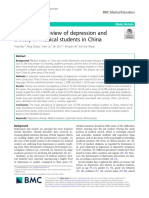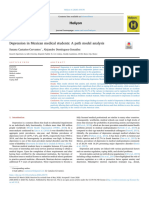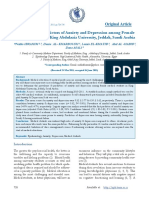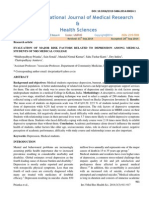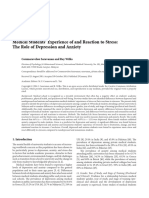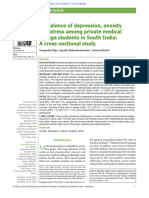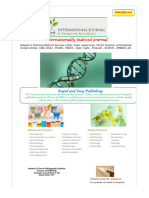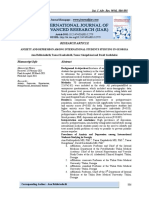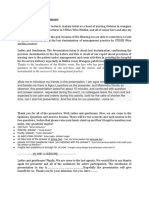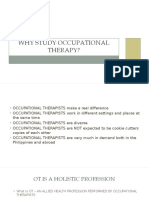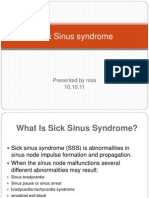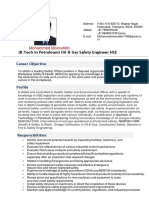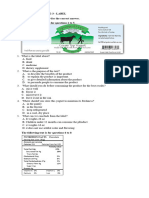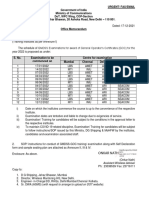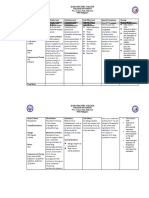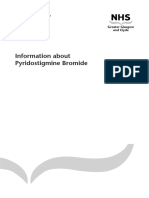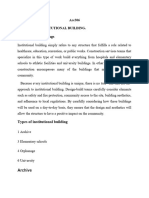Prevalence and Predictors of Depression and Anxiet
Uploaded by
misaelbelete05Prevalence and Predictors of Depression and Anxiet
Uploaded by
misaelbelete05Kebede et al.
Int J Ment Health Syst (2019) 13:30
https://doi.org/10.1186/s13033-019-0287-6 International Journal of
Mental Health Systems
RESEARCH Open Access
Prevalence and predictors of depression
and anxiety among medical students in Addis
Ababa, Ethiopia
Mebratu Abraha Kebede1*, Birke Anbessie1 and Getinet Ayano2
Abstract
Background: Depression and anxiety are among the common mental health problems among medical students
and are associated with poor academic performance, disability and poor quality of life. A better understanding of
the magnitude and correlates of depression and anxiety is essential for planning appropriate intervention for those
population groups. However, research into depression and anxiety and the potential contributing factors is limited in
low and middle-income countries including Ethiopia. Therefore, this study aimed to determine the prevalence and
associated factors of depression and anxiety among medical students.
Methods: A cross-sectional study was conducted among 273 medical students selected by systematic sampling
technique. Hospital anxiety and depression scale (HADS) was used to assess anxiety and depression. Binary and mul-
tivariable logistic regression models were fitted, adjusting for the potential confounding factors. Odds ratios (OR) with
the corresponding 95% confidence interval (95% CI) was computed to assess the strength of association.
Result: The prevalence of co-morbid depression and anxiety was found to be 21.20% (16.35% to 26.05%) and preva-
lence of depression and anxiety was 51.30% (45.37% to 57.23%) and (30.1% 24.66% to 35.54%), respectively. Multivari-
ate analysis showed that being female [AOR 2.56, 95% CI (1.32, 4.95)], first-year educational level [AOR 12.06, 95% CI
(2.18, 66.72)], second-year educational level [AOR 8.99, 95% CI (1.67, 48.45)] and those who had poor/low social sup-
port [AOR 5.36, 95% CI (2.08, 13.76)] were significantly association with anxiety. Students who were in the age interval
of 18–21 years [AOR 2.42, 95% CI (1.64, 9.22)], first-year educational level [AOR 1.63, 95% CI (1.43, 6.26)], second-year
educational level [AOR 1.39, 95% CI (1.17, 5.18)] and who had stressful life events [AOR 1.61, 95% CI (1.14, 2.76)] were
significantly associated with depression among medical students.
Conclusion: The current study demonstrated that a remarkable proportion of medical students are suffering from
depression (51.30%), anxiety (30.10%) as well as comorbid depression and anxiety (21.20%). There was strong evi-
dence of association between anxiety and female sex, first-year educational level, second-year educational level and
having poor/low social support. Whereas a significant association was observed between depression and younger
age (18–21 years old), first-year educational level, second-year educational level and having one or more stressful life
events in the last 6 months. Screening of depression and anxiety among medical students was recommended. Future
studies focusing on better ways of preventing and treating depression and anxiety among medical students are
warranted.
Keywords: Depression, Anxiety, Medical students, Predictors, Ethiopia
*Correspondence: mebratuabraha21@gmail.com
1
Department of Research, Saint Paul Hospital Millennium Medical
College, POBox 171, Addis Ababa, Ethiopia
Full list of author information is available at the end of the article
© The Author(s) 2019. This article is distributed under the terms of the Creative Commons Attribution 4.0 International License
(http://creativecommons.org/licenses/by/4.0/), which permits unrestricted use, distribution, and reproduction in any medium,
provided you give appropriate credit to the original author(s) and the source, provide a link to the Creative Commons license,
and indicate if changes were made. The Creative Commons Public Domain Dedication waiver (http://creativecommons.org/
publicdomain/zero/1.0/) applies to the data made available in this article, unless otherwise stated.
Content courtesy of Springer Nature, terms of use apply. Rights reserved.
Kebede et al. Int J Ment Health Syst (2019) 13:30 Page 2 of 8
Background Attending university is a particularly stressful time due
Depression is a significant public health problem and to unique emergent stressors such as changes in environ-
is characterized by sadness, loss of interest in activi- ment, loss or diminishment of social support networks,
ties and by decreased energy. It is differentiated from academic pressures, developing peer relationships, and
normal mood changes by the extent of its severity, the financial management [14]. The current educational
symptoms and the duration of the disorder [1]. Depres- process may have a negative effect on students’ mental
sion is the fourth most important contributor to the health, with a high frequency of anxiety among medical
global burden of disease and 4.4% of the total disability students [15].
adjusted life years (DAILY) is explained by depression Even though depression and anxiety are found to be
[2, 3]. Epidemiologic evidence also showed that about remarkably high among medical students coupled with
1.2% of the total burden in Africa to 8.9% in high- their impacts in causing poor academic performance,
income countries is explained by depression [4]. disability and poor quality of life, to our knowledge a few
Depression is common in university students espe- studies are available in East Africa including the study
cially it is high among medical students with no pre- area (Ethiopia). Therefore, this study aimed to assess the
ponderance between males and females and in single prevalence and factors associated with depression and
students is higher than married ones [5, 6]. It may be anxiety among medical students in the study area.
a significant hidden problem in medical students and
mechanisms to identify and help students with mental Methods and materials
health problems should be seriously considered [7]. The Study setting, study design and period
high prevalence suggests that immediate preventive Institutional based cross-sectional study was conducted
measures should be implemented, such as the setting from April to May 2017, at St. Paul Hospital millennium
up of psycho-pedagogic support services for students, medical college, Addis Ababa, Ethiopia.
and teacher development programs [8].
Anxiety is a vague feeling of apprehension, worry, Study population
uneasiness, or dread, the source of which is often The study population consisted of All St. Paul Hospital
non-specific or unknown to the individual [9]. Anxi- millennium medical college medical students (from year
ety and depression have a huge effect on society one to internship) who were included in the sample.
and individual, which can lead to the suicidal ten-
dency, relationship problems, medical dropouts, and Sampling procedure
impaired work ability. Therefore, proper counseling The sample size was determined based on a single popu-
services required to the psychological well-being of lation proportion formula using Epi-info version 7 with a
medical students to improve their quality of life [10]. 95% CI, 5% margin of error and taking the prevalence of
Symptoms of depression and anxiety disorders have depression and anxiety 27.7% [26] and 40.9% [25] respec-
the most significant impact on health-related quality tively. By considering a 10% non-response rate and apply-
of life (HRQOL) [11]. ing sample correction formula a total sample size of 273
Psychological illnesses in the form of depression, anx- undergraduate medical students were involved in the
iety, and stress have been reported in a substantial pro- study.
portion of first-year medical students. Multiple social, We used a systematic random sampling technique to
demographic, behavioral, and academic factors have select two hundred seventy-three (273) medical stu-
been found to be significantly associated with most of dents who were included in the study. We determined the
the studied psychological morbidities; among them, sampling interval by dividing the total study population
gender, residence, feeling loneliness, the inability to (medical students) by the total sample size which was
share families in social activities, presence of insomnia two. The first study participant was selected using lottery
and chronic physical illnesses, studying in English lan- method and the next study participants were choose at a
guage, problems with exams’ criteria, and the organiza- regular interval (every second interval) and interviewed
tion of lectures’ timetable were the most common [12]. by data collectors.
Emotional disturbances in the form of depression and
anxiety exist in high rate among undergraduate science Data collection procedures and instrument
students that require early intervention. Factors includ- Data were collected using pretested an interviewer-
ing the feeling of incompetence, lack of motivation to administered questionnaire, which contains data on
learn and difficulty of class work can be considered as a the outcome of interest (depression and anxiety), socio-
source of stressors that may precipitate for depression demographic characteristics (age, sex, source of income
and anxiety [13]. and marital status), academic-related factors (academic
Content courtesy of Springer Nature, terms of use apply. Rights reserved.
Kebede et al. Int J Ment Health Syst (2019) 13:30 Page 3 of 8
year of study, duration of the vacation, impact of educa- discussing, the ultimate purpose and method of the
tional vocation and academic interest), clinical factors study, written consent was sought from SPHMMC
(family history of mental illness, chronic illness), psycho- and informed verbal consent was obtained from each
social factors (social support, stressful life events) as well respondent. The respondents were informed that their
as substance-related factors (khat, alcohol, tobacco and inclusion in the study was voluntary and they were
others). free to withdraw from the study if they are not will-
The hospital anxiety and depression scale (HADS) was ing to participate. If any question they do not want
used to measure depression and anxiety among medical to answer they had the right to do so. To ensure the
students [16]. HADS was validated and extensively used confidentiality of respondents, their names were left
in Ethiopia [17, 18]. The tool containing 14 questions out on the questionnaire. All interviews were indi-
with a cut-off score for depression and anxiety of greater vidually to keep confidentiality. All study participants
than or equal to 8 [16]. who become case were linked to an outpatient psychi-
Social support was measured by Oslo 3-item social atric clinic at SPHMMC after getting permission from
support scale and individual who scored 3–8, 9–11, and them.
12–14 were considered as having poor, moderate and
strong social support respectively [19].
Stressful life events were measured using self-report Result
of experiencing one or more major stressful life events Socio‑demographic characteristics of the respondents
(including health-related problems, death significant oth- A total of 273 participants were included in the study
ers, and financial crisis) in the last 6 months. which makes the response rate 98.5%. The mean age
In the current study, substance use such as alcohol, of the respondents was 1.61 (SD = 0.65) years. Among
cigarette, and khat indicates current use. Of those sub- the respondents, the majority 129 (48%) were in the
stances. Those participants who have a history of sub- age range of 18–21 years, 163 (60.6%) were male, 256
stance use in the last month were considered as current (95.2%) were unmarried, 163 (60.6%) were orthodox
users. religion members and 249 (92.6%) had no additional
source of income (Table 1).
Data quality control issues
The training was given to the data collectors and supervi-
sors on the data collection tool and sampling techniques
by the researcher. Supervision was held regularly during Table 1 Descriptions of Socio demographic characteristics
the data collection period both by the researcher, co- among undergraduate medical students at SPHMMC,
investigators and supervisors to check on a daily basis for Addis Ababa, Ethiopia, 2016/2017
completeness and consistency. Variables Frequency Percent (%)
Age (years)
Data processing and analysis
18–21 129 48.0
After cleaning, data was entered, into EPI info version
22–24 115 42.8
3.14 then it was exported to SPSS versions 20 for analysis.
25 and above 25 9.3
Descriptive statistics (frequencies and percentages) was
Sex
used to explain the study participant in relation to study
Male 163 60.6
variables. Bivariate and multivariate analysis was used to
Female 106 39.4
determine the presences of statistically significant associ-
Marital status
ations between the independent variables and depression
Married 13 4.8
and anxiety. Those variables having a p-value less than
Unmarried 256 95.2
0.2 were entered into the multivariate logistic regression
Religion
model to identify the effect of each independent variable
Orthodox 163 60.6
with the outcome variables. The strength of the asso-
Muslim 42 15.6
ciation was presented by odds ratio and 95% confidence
Protestant 54 20.1
interval. A p-value of < 0.05 on multivariate analyses was
Catholic 7 2.6
considered as statistically significant.
Others 3 1.1
Source of income
Ethical considerations
Yes 20 7.4
Ethical clearance was obtained from the IRB ethi-
No 249 92.6
cal review board of SPHMMC. After thoroughly
Content courtesy of Springer Nature, terms of use apply. Rights reserved.
Kebede et al. Int J Ment Health Syst (2019) 13:30 Page 4 of 8
Educational, clinical, psychosocial and substance use Table 2 Description of clinical, psychosocial
characteristics of the respondents and substance use characteristics among undergraduate
The majority of the participants had the interest to study medical students at SPHMMC, Addis Ababa, Ethiopia,
medical health 222 (82.5%). About 189 (70.3%) of them 2016/2017
reported that a short vocational status (part-time work). Variables Frequency Percent (%)
However, most of the participants who had part-time
Level of education
work 163 (60.6%) reported that the length of the voca-
1st year 58 21.6
tional period does not have an impact on their education.
2nd year 52 19.3
Regarding clinical related characteristics, most of the
3rd year 46 17.1
participant had no history of chronic illness (94.4%) as
well as a family history of mental illness (90.3%). Nearly 4th year 41 15.2
half of the participant 129 (48%) had intermediate 5th year 37 13.8
social support and 29% of the participant had low social 6th year 35 13.0
support. Interest of education
More than half of students had no history of stressful Yes 222 82.5
life events in last 6 month 144 (53.5%) and 206 (76.6%) No 47 17.5
of them had no any history of substance (khat, cigarette, Vocational status
and alcohol) use in the last 3 months (Table 2). Short 189 70.3
Medium 76 28.3
Long 4 1.5
The magnitude of depression and anxiety among medical Impact of educational vocation
students Yes 163 60.6
The prevalence of co-morbid depression and anxiety was No 106 39.4
found to be 21.20% (16.35% to 26.05%) and prevalence of Diagnosed chronic illness
depression and anxiety was 51.3% (45.37% to 57.23%) and Yes 15 5.6
(30.1% 24.66% to 35.54%), respectively. No 254 94.4
Family history of mental illness
Yes 26 9.7
Factors associated with depression and anxiety
No 243 90.3
among medical students
Social support
The multivariable logistic regression revealed that the
Low social support 78 29.0
odds of anxiety was higher among medical students who
Medium social support 129 48.0
are female adjusted odds ratios [AORs, 2.56, 95% CI
Good social support 62 23.0
(1.32, 4.95)], first-year educational level [AOR 12.06, 95%
Stressful life events
CI (2.18, 66.72)], second-year educational level [AOR
No 144 53.5
8.99, 95% CI (1.67, 48.45)] and those who had poor/low
Yes 125 46.5
social support [AOR 5.36, 95% CI (2.08, 13.76) (Table 3).
Current substance (khat, cigarette and alcohol) use
Whereas, being in age ranges between 18 and 21 years
Yes 63 23.4
[AOR 2.42, 95% CI (1.64, 9.22)], first-year educational
No 206 76.6
level [AOR 1.63, 95% CI (1.43, 6.26)], second-year educa-
tional level [AOR 1.39, 95% CI (1.17, 5.18)] and who had
stressful life events [AOR 1.61, 95% CI (1.14, 2.76)] were
significant associated with depression among medical students found to have depression and one in three and
students (Table 4). one in five of the students reported anxiety and comorbid
depression and anxiety, respectively.
Discussion The prevalence and associated factors of anxiety
Main findings The magnitude of anxiety among medical students in the
In this study, the prevalence of depression and anxiety current study (30.1%) was in line with other study con-
among medical students and their possible association ducted in Brazil 33.7% [8]. Contrarily the prevalence of
with various variables were assessed. The results from anxiety in the current study was higher than the studies
the current survey revealed that a remarkable propor- conducted in India (9.8%) [10], and Nepal (5%) [20]. Fur-
tion of medical students had depression, anxiety as well thermore, the magnitude of anxiety in the current study
as comorbid depression and anxiety. One in two medical was lower than the studies conducted in Egypt (73%)
Content courtesy of Springer Nature, terms of use apply. Rights reserved.
Kebede et al. Int J Ment Health Syst (2019) 13:30 Page 5 of 8
Table 3 Factors associated with anxiety Table 3 (continued)
among undergraduate medical students at SPHMMC, Explanatory Anxiety COR, 95% (CI) AOR, 95% (CI)
Addis Ababa, Ethiopia, 2016/2017 variables
Yes No
Explanatory Anxiety COR, 95% (CI) AOR, 95% (CI)
variables Substance use
Yes No
Yes 18 46 0.88 (0.47, 1.64) 0.85 (0.41, 1.77)
Sex No 63 142 1 1
Male 40 123 1 1 n = 269
Female 41 65 1.94 (1.14, 3.29)* 2.56 (1.32, 4.95)** Diagnosed chronic illness = cardiovascular disease, liver diseases, Epilepsy, HIV/
Age AIDS…
18–21 51 78 1.39 (0.56, 3.46) 0.26 (0.05, 1.22) * Significant association (p-value < 0.2 in bivariate)
22–24 52 93 0.50 (0.19, 1.31) 0.30 (0.08, 1.10) ** Significant association (p-value < 0.05 in multivariate analysis) Hosmer and
Lemeshow test = 0.317
25 and above 8 17 1 1
Marital status
Married 1 11 1 1
Single 80 177 4.97 (0.63, 39.17) 3.23 (0.35, 29.63)
Source of income
[21], Bahrein (51%) [22], and Brazil (37.2%) [22], Ethio-
Yes 2 18 1 1
pia) (40.9%) [23], Egypt (78.4%) [12], Pakistan (70.7%)
No 79 170 0.24 (0.05, 1.06) 1.450 (0.28, 7.85) [24], India (66.9%) [25], and in (84.5%) [13]. The possible
Educational level reasons for the observed difference include the instru-
1st year 29 29 4.83 (1.75, 13.39)* 12.06 (2.18, 66.72)** ment used to measure anxiety, the sample size, the course
2nd year 22 30 3.54 (1.26, 9.99)* 8.99 (1.67, 48.45)** load and the existing socio-cultural differences among
3rd year 10 36 1.34 (0.41, 4.13) 3.42 (0.76, 15.33) the countries.
4th year 8 33 1.17 (0.36, 3.78) 2.07 (0.42, 10.15) Regarding associated factors, the multivariate logis-
5th year 6 31 0.94 (0.27, 3.23) 1.90 (0.41, 8.81) tic regression analysis in the current study showed that
6th year 6 29 1 1 being females were 2.56 times more likely to have anxi-
Interest toward medical education ety than males. The possible reason might be increased
Yes 63 159 1 1 exposure to acute life events, gender-specific roles, and
No 18 29 1.57 (0.81, 3.02) 1.46 (0.76, 3.18) smaller social networks. The current result is smaller
Vocational period than the study conducted in Northeast Brazil [8] but
Short 65 124 1.573 (0.16, 15.42) 4.00 (0.33, 48.11) higher than the study conducted in the University of
Medium 15 61 0.738 (0.07, 7.60) 2.28 (0.17, 29.86) Gondar, Ethiopia [23].
Long 1 4 1 1 Students who were the first year medical students had
Impact of vocational period 12.06 times more likely to have anxiety as compared with
Yes 57 106 1.84 (1.05, 3.21)* 1.47 (0.73, 2.93) those who were 6-year medical students. This might be
No 24 82 1 1 due to exposure to a new environment, new friends,
Diagnosed chronic illness apart from family or new teaching–learning process. This
Yes 6 9 1.59 (0.55, 4.63) 1.02 (0.20, 3.62) is relatively higher than the study conducted previously
No 75 179 1 1 in Abbottabad (Pakistan) [15]; this might be due to the
Family history of mental illness difference in socio-demographic, culture, teaching envi-
Yes 11 15 1.81 (0.79, 4.14) 2.55 (0.89, 7.23) ronment or curriculum.
No 70 173 1 In addition, students who were second-year medical
Social support students had 8.99 times more likely to have anxiety as
Low/poor 35 43 3.77 (1.71, 8.31)* 5.36 (2.08, 13.76)** compared with those who were a six-year medical stu-
Medium/interme- 35 94 1.73 (0.81, 3.69) 2.23 (0.98, 5.32) dent which is high. This might be due to the number of
diate
credit hours of the lesson, exposed to new medical words
High/good 11 51 1 1
Stressful life events
which are difficult to understand and easily hold and tak-
No 35 109 1 1
ing the exam frequently.
Yes 46 79 1.81 (1.07, 3.07)* 1.26 (0.67. 2.34)
Content courtesy of Springer Nature, terms of use apply. Rights reserved.
Kebede et al. Int J Ment Health Syst (2019) 13:30 Page 6 of 8
Table 4 Factors associated with depression Table 4 (continued)
among undergraduate medical students at SPHMMC, Explanatory Depression COR, 95% (CI) AOR, 95% (CI)
Addis Ababa, Ethiopia, 2016/2017 variables
Yes No
Explanatory Depression COR, 95% (CI) AOR, 95% (CI)
variables Substance use
Yes No
Yes 34 30 1.10 (0.62, 1.93) 1.35 (0.73, 2.53)
Sex No 128 101 1 1
Male 81 80 1 1
n = 269
Female 50 56 1.11 (0.68, 1.81) 0.99 (0.57, 1.75) Diagnosed chronic illness = cardiovascular disease, liver diseases, Epilepsy, HIV/
Age AIDS…
18–21 77 52 2.63 (1.08, 6.41)* 2.42 (1.64, 9.22)** * Significant association (p-value < 0.2 in bivariate)
22–24 52 63 1.47 (0.60, 3.59) 1.90 (0.63, 5.69) ** Significant association (p-value < 0.05 in multivariate analysis) Hosmer and
Lemeshow test = 0.161
25 and above 9 16 1 1
Marital status
Married 1 11 1 1
Single 137 120 0.51 (0.15, 1.74) 0.27 (0.58, 0.98) Regarding social support, students who had poor/low
Source of income social support were 5.36 times more likely to have anxiety
Yes 8 12 1 1 than students who had good social support; this might be
No 130 119 1.64 (0.65, 4.15) 2.21 (0.76, 6.40) due to the feeling of loneliness and lack of social inter-
Educational level action. The current result is higher than the study con-
1st year 38 20 2.85 (1.20, 6.78)* 1.63 (1.43, 6.26)** ducted at the University of Gondar, Ethiopia [23].
2nd year 34 18 2.83 (1.17, 6.87)* 1.39 (1.17, 5.18)**
3rd year 18 28 0.96 (0.39, 2.37) 0.50 (0.16, 1.65)
The prevalence and factors associated with depression
4th year 16 25 0.96 (0.38, 2.41) 0.52 (0.16, 1.68)
The study revealed that the prevalence of depression was
5th year 18 19 1.42 (0.56, 3.62) 1.01 (0.33, 3.04)
(51.3% (CI 46.0, 56.9) high. Regarding the prevalence, the
6th year 14 21 1 1
current study’s finding was similar to other studies car-
Interest toward medical education
ried out in the different area of India 49.1% [7] and 51.3%
Yes 109 18 1 1
[25]. However, the current study result is higher than the
No 29 113 1.67 (0.88, 3.180 1.86 (0.90, 3.82)
studies conducted in Addis Ababa University (Ethiopia)
Vocational period
which were 27.7% [26], in University of Gondar (Ethio-
Short 98 91 1.08 (0.15, 7.81) 1.37 (0.15, 12.85)
pia) which was 40.9% [23], in Madinah (Saudi Arabia)
Medium 38 38 1.00 (0.13, 7.47) 1.48 (0.15, 14.82)
Long 2 2 1 1
which was 28.3% [27], Sangareddy (India) which was 14%
Impact of vocational period
[10] and North East Brazil which was 33.7% [8]; but lower
Yes 82 81 0.90 (0.55, 1.48) 0.81 (0.45, 1.47)
than the study conducted in Egypt which was 63.6% [12],
No 56 50 1 1
in Tabriz (Iran) which was 62.7% [28], in Malaysia which
Diagnosed chronic illness was 64.4% [13], in India which was 58% [5] and in Kara-
Yes 10 5 1.97 (0.65, 5.92) 2.36 (0.69, 8.13) chi (Pakistan) which was 70% [24]. The variation might
No 128 126 1 1 be due to the difference in sample size and data collec-
Family history of mental illness tion tool which was SRQ-20 with 836 participants in the
Yes 15 11 1.33 (0.59, 3.01) 1.25 (0.50, 3.11) University of Gondar, Ethiopia [23], DASS-21 with 421
No 123 120 1 1 participants in Egypt [12], PQ-2 with 60 participants in
Social support Madinah, Saudi Arabia [27], BDI with 175 participants
Low/poor 41 37 1.53 (1.18, 3.01)* 1.32 (0.63, 2.73) in Tabziz, Iran [28], DASS-21 with 194 participants in
Medium/inter- 71 58 1.70 (0.92, 3.13) 1.76 (0.90, 3.43) Malaysia [13], BDI with participant in India [7], SRQ-20
mediate with 172 participants in North east Brazil [8];difference
High/good 26 36 1 1 in data collection tool which was CES-D in Addis Ababa
Stressful life events University, Ethiopia [26], DASS-21 in Odisha, India [25],
No 64 80 1 1 PHQ-9 in India [5], DASS-42 Sangareddy, India [10] and
Yes 74 51 1.81 (1.12, 2.95)* 1.61 (1.14, 2.76)** AKUADS in Karachi (Pakistan) [24].
Content courtesy of Springer Nature, terms of use apply. Rights reserved.
Kebede et al. Int J Ment Health Syst (2019) 13:30 Page 7 of 8
The multivariate logistic regression analysis in the cur- younger age (18–21 years old), first-year educational
rent study showed that students who were in the age level, second-year educational level and having one or
interval of 18–21 years were 2.42 times more likely to more stressful life events in the last 6 months. Screen-
have depression as compared than those who were 25 ing of depression and anxiety among medical students
and above years old. The current result is similar to the was recommended. Future studies focusing on better
study conducted in the International Islamic University ways of preventing and treating depression and anxiety
of Malaysia [13]. among medical students are warranted.
Regarding educational level, those who are the first
Acknowledgements
year and second-year medical students were 1.63 and The authors acknowledge saint Paul Hospital Millennium Medical College,
1.39 times more likely to have depression respectively as Ethiopia for funding the study and the IRB of the institution for their ethi-
compared to those who were 6-year medical students. cal evaluation and approval. The authors appreciate the respective study
institutions and the study participants for their cooperation in providing the
The current finding is similar to the study conducted in necessary information.
India [5]. This might be due to lack of social interaction;
unfamiliar types exam schedule; lower grade than antici- Authors’ contributions
MAK conceived the study and was involved in the study design, reviewed the
pated; lack of vacation or break [23] or language problem article, analysis, report writing and drafted the manuscript. GA were involved
[7]. in the study design, analysis and drafted the manuscript. BA was involved in
With respect to stressful life events, students who writing and edition of revised manuscript. All authors read and approved the
final manuscript.
had faced one or more of stressful life events in the last
6 months were 1.61 times more likely to have depres- Funding
sion as compared to those who had not faced stressful life This research work is funded by Saint Paul Hospital Millennium Medical Col-
lege, federal ministry of health of Ethiopia.
events in the last 6 months. This might be due to the loss
of close family or friends; financial crises or family prob- Ethics approval and consent to participate
lems. The current result is lower than the study conducted Ethical approval was obtained from Saint Paul Hospital Millennium Medical
College. Confidentiality was maintained at all levels of the survey. Informed,
in India [5] and the University of Gondar, Ethiopia [23]. written consent was obtained from each study participant. The right to with-
draw from the research process at any point in time was respected. Privacy
The strength and limitation of the study and strict confidentiality was maintained during the interview process.
The present study had several strengths: (1) We used Consent for publication
adequate sample size and the participants were involved Not applicable.
from a well-defined catchment area; (2) We measure
Competing interests
our outcome of interest (depression and anxiety) using The authors declare that they have no competing interests.
standard and validated instrument (HADS); (3) we also
estimated the prevalence of coexisting anxiety and Author details
1
Department of Research, Saint Paul Hospital Millennium Medical College,
depression among the study participants. POBox 171, Addis Ababa, Ethiopia. 2 Research and Training Department,
However, the current study also had some limitations: Amanuel Mental Specialized Hospital, Addis Ababa, Ethiopia.
first, due to the cross sectional nature of the study the
Received: 4 January 2019 Accepted: 29 April 2019
association between different factors and anxiety as
well as depression may not imply causation; second, the
possibility of recall bias because of the retrospective
nature of cross-sectional studies: thirdly, not measur- References
ing the effects of other comorbid psychiatric disorders 1. Marianne C, Kastrup M, Armando Báez Ramos MD. Global mental health.
may overestimated or underestimate the observed Dan Med Bull. 2007;54:42–3.
2. Sidi H, et al. Depression and the associated factors among elderly hyper-
associations. tensives. Exp Clin Cardiovasc. 2014;20(5):3065–72.
3. Michelle FGI. Integrating mental health into primary care: a global per-
spective. Geneva: WHO; 2008.
4. Diego TW-SS. Handbook of cultural psychiatry. New York: Academic Press;
Conclusion 2001.
The present study revealed a considerably higher preva- 5. RanuRawat SK, Manju L. Prevalence of depression and its associated fac-
lence of comorbid anxiety and depression (21.20%), tors among medical students of a private medical college in south India.
Int J Commun Med Public Health. 2016;3(6):1393–8.
depression (51.3%), and anxiety (30.1%), among medi- 6. Diana Sarokhani AD, Yousef V, et al. Prevalence of depression among
cal students. There was strong evidence of an asso- university students: a systematic review and meta-analysis study. London:
ciation between anxiety and female sex, first-year Hindawi Publishing Corporation; 2013. p. 7.
7. Singh A, Shekhar L. Prevalence of depression among medical students of
educational level, second-year educational level and a private medical college in India. Online J Health Allied Sci. 2010;9(4):8.
having poor/low social support. Whereas a signifi- 8. Edméa Fontes de Oliva Costa MVR, Ana Teresa Rodrigues de Abreu S,
cant association was observed between depression and et al. Common mental disorders and associated factors among final-year
healthcare students. Rev Assoc Med Brasil. 2014;60(6):525–30.
Content courtesy of Springer Nature, terms of use apply. Rights reserved.
Kebede et al. Int J Ment Health Syst (2019) 13:30 Page 8 of 8
9. Robert MA, Hirschfeld MD. The comorbidity of major depression and 20. Adhikari A, Dutta A, Sapkota S, Chapagain A, Aryal A, Pradhan A. Preva-
anxiety disorders: recognition and management in primary care. Primary lence of poor mental health among medical students in Nepal: a cross-
Care Companion J Clin Psychiatry. 2001;3:6. sectional study. BMC Med Educ. 2017;17(1):232.
10. Suresh C. Prevalence and associated factors of depression, anxiety and 21. Fawzy M, Hamed SA. Prevalence of psychological stress, depres-
stress among undergraduate medical students. Int J Indian Psychol. sion and anxiety among medical students in Egypt. Psychiatry Res.
2016;3(4):2348–5396. 2017;255:186–94.
11. Dejan Stevanovic J, Aneta L. The impact of depression and anxiety 22. Mahroon ZA, Borgan SM, Kamel C, Maddison W, Royston M, Donnellan C.
disorder symptoms on the health-related quality of life of children and Factors associated with depression and anxiety symptoms among medi-
adolescents with epilepsy. Epilepsia. 2011;52(8):75–8. cal students in Bahrain. Acad Psychiatry. 2018;42(1):31–40.
12. Gabr AR. Depression, anxiety and stress among first year medi- 23. Berihun Assefa Dachew TAB, Resom Berhe G. Prevalence of mental dis-
cal students in an Egyptian public university. Int Res J Med Med Sci. tress and associated factors among undergraduate students of University
2014;2(2354-211X):11–9. of Gondar, Northwest Ethiopia: a cross-sectional institutional based study.
13. Radeef AS, Faisal GG, Ali SM, Ismail MK. Source of stressors and emotional PLoS ONE. 2015;10:0119464.
disturbances among undergraduate science students in Malaysia. Int J 24. Muhammad S, Khan S, Areef B, Syed UA. Prevalence of depression,
Med Res Health Sci. 2014;3(2):401–10. anxiety and their associated factors among medical students in Karachi,
14. Aileen M, Pidgeon NFR, Peta S, Heidi BM, Barbara C, Lo Y. Examining char- Pakistan. J Pak Med Assoc. 2006;56:12.
acteristics of resilience among University students: an international study. 25. Shawaz Iqbal SGEV. Stress, anxiety & depression among medical under-
Open J Soc Sci. 2014;2:14–22. graduate students & their socio-demographic correlates. Indian J Med
15. Sundas Ishtiaq MK, Anum S, Saira M. Prevalence of study related anxiety Res. 2015;141:354–7.
among female medical students. ISRA Med J. 2013;5:2. 26. Berhanu Y. Prevalence of depression and associated factors among addis
16. Reda AA. Reliability and validity of the Ethiopian version of the hospital ababa university students, Addis Ababa, Ethiopia. J Multidisciplin Res
anxiety and depression scale (HADS) in HIV infected patients. PLoS ONE. Healthcare. 2015;2(1):73–90.
2011;6:1. 27. Saud A, Sultan AAA, Shahad AS. Prevalence of depression among medical
17. Tesfaw G, Ayano G, Awoke T, Assefa D, Birhanu Z, Miheretie G, et al. students at Taibah University, Madinah, Saudi Arabia. Int J Acad Sci Res.
Prevalence and correlates of depression and anxiety among patients with 2016;4(1):93–102.
HIV on-follow up at Alert Hospital, Addis Ababa, Ethiopia. BMC Psychiatry. 28. Saeid Safiri NK, Ahmad K, Mohammad Reza N, Nahid K. Prevalence of
2016;16(1):368. depression and its associated factors using Beck Depression Inventory
18. Duko B, Gebeyehu A, Ayano G. Prevalence and correlates of depression among students of School of Health and Nutrition, Tabriz, Iran in 2009. J
and anxiety among patients with tuberculosis at WolaitaSodo University Anal Res Clin Med. 2013;1(2):83–9.
Hospital and Sodo Health Center, WolaitaSodo, South Ethiopia, cross
sectional study. BMC Psychiatry. 2015;15:214.
19. Dalgard OS, Lehtinen V, Vazquez-Barquero JL, Casey P, Wilkinson G, Ayuso- Publisher’s Note
Mateos JL, Page H, Dunn G. Social support and gender difference in Springer Nature remains neutral with regard to jurisdictional claims in pub-
depression. Soc Psychiatry Psychiatr Epidemiol. 2006;42(6):444–51. lished maps and institutional affiliations.
Ready to submit your research ? Choose BMC and benefit from:
• fast, convenient online submission
• thorough peer review by experienced researchers in your field
• rapid publication on acceptance
• support for research data, including large and complex data types
• gold Open Access which fosters wider collaboration and increased citations
• maximum visibility for your research: over 100M website views per year
At BMC, research is always in progress.
Learn more biomedcentral.com/submissions
Content courtesy of Springer Nature, terms of use apply. Rights reserved.
Terms and Conditions
Springer Nature journal content, brought to you courtesy of Springer Nature Customer Service Center GmbH (“Springer Nature”).
Springer Nature supports a reasonable amount of sharing of research papers by authors, subscribers and authorised users (“Users”), for small-
scale personal, non-commercial use provided that all copyright, trade and service marks and other proprietary notices are maintained. By
accessing, sharing, receiving or otherwise using the Springer Nature journal content you agree to these terms of use (“Terms”). For these
purposes, Springer Nature considers academic use (by researchers and students) to be non-commercial.
These Terms are supplementary and will apply in addition to any applicable website terms and conditions, a relevant site licence or a personal
subscription. These Terms will prevail over any conflict or ambiguity with regards to the relevant terms, a site licence or a personal subscription
(to the extent of the conflict or ambiguity only). For Creative Commons-licensed articles, the terms of the Creative Commons license used will
apply.
We collect and use personal data to provide access to the Springer Nature journal content. We may also use these personal data internally within
ResearchGate and Springer Nature and as agreed share it, in an anonymised way, for purposes of tracking, analysis and reporting. We will not
otherwise disclose your personal data outside the ResearchGate or the Springer Nature group of companies unless we have your permission as
detailed in the Privacy Policy.
While Users may use the Springer Nature journal content for small scale, personal non-commercial use, it is important to note that Users may
not:
1. use such content for the purpose of providing other users with access on a regular or large scale basis or as a means to circumvent access
control;
2. use such content where to do so would be considered a criminal or statutory offence in any jurisdiction, or gives rise to civil liability, or is
otherwise unlawful;
3. falsely or misleadingly imply or suggest endorsement, approval , sponsorship, or association unless explicitly agreed to by Springer Nature in
writing;
4. use bots or other automated methods to access the content or redirect messages
5. override any security feature or exclusionary protocol; or
6. share the content in order to create substitute for Springer Nature products or services or a systematic database of Springer Nature journal
content.
In line with the restriction against commercial use, Springer Nature does not permit the creation of a product or service that creates revenue,
royalties, rent or income from our content or its inclusion as part of a paid for service or for other commercial gain. Springer Nature journal
content cannot be used for inter-library loans and librarians may not upload Springer Nature journal content on a large scale into their, or any
other, institutional repository.
These terms of use are reviewed regularly and may be amended at any time. Springer Nature is not obligated to publish any information or
content on this website and may remove it or features or functionality at our sole discretion, at any time with or without notice. Springer Nature
may revoke this licence to you at any time and remove access to any copies of the Springer Nature journal content which have been saved.
To the fullest extent permitted by law, Springer Nature makes no warranties, representations or guarantees to Users, either express or implied
with respect to the Springer nature journal content and all parties disclaim and waive any implied warranties or warranties imposed by law,
including merchantability or fitness for any particular purpose.
Please note that these rights do not automatically extend to content, data or other material published by Springer Nature that may be licensed
from third parties.
If you would like to use or distribute our Springer Nature journal content to a wider audience or on a regular basis or in any other manner not
expressly permitted by these Terms, please contact Springer Nature at
onlineservice@springernature.com
You might also like
- 1 - Tabalipa - Prevalência de Ansiedade e DepressãoNo ratings yet1 - Tabalipa - Prevalência de Ansiedade e Depressão7 pages
- A Systematic Review of Depression and Anxiety in Medical Students in ChinaNo ratings yetA Systematic Review of Depression and Anxiety in Medical Students in China13 pages
- Study About Anxiety Among Medical and College StudentsNo ratings yetStudy About Anxiety Among Medical and College Students4 pages
- Original Article Prevalence of Depression, Anxiety and Their Associated Factors Among Medical Stu-Dents in Karachi, PakistanNo ratings yetOriginal Article Prevalence of Depression, Anxiety and Their Associated Factors Among Medical Stu-Dents in Karachi, Pakistan4 pages
- 3 Original Research Article A Study To AccessNo ratings yet3 Original Research Article A Study To Access7 pages
- Depression in Mexican Medical Students A Path Model AnalysisNo ratings yetDepression in Mexican Medical Students A Path Model Analysis7 pages
- Prevalence and Predictors of Anxiety and Depression Among Female Medical Students in King Abdulaziz University, Jeddah, Saudi ArabiaNo ratings yetPrevalence and Predictors of Anxiety and Depression Among Female Medical Students in King Abdulaziz University, Jeddah, Saudi Arabia12 pages
- Depression, Anxiety, and Stress Among Hawler Medical University, Erbil, IraqNo ratings yetDepression, Anxiety, and Stress Among Hawler Medical University, Erbil, Iraq10 pages
- Factors Associated To Depression and Anxiety in Medical Students: A Multicenter StudyNo ratings yetFactors Associated To Depression and Anxiety in Medical Students: A Multicenter Study10 pages
- 67589-Redrafted Arpitakabiraj F (Is) Pf1 (Da Om) Redo Pfa (Shu) Ref - Pat (Om) PB (Da Om) PN (Om)No ratings yet67589-Redrafted Arpitakabiraj F (Is) Pf1 (Da Om) Redo Pfa (Shu) Ref - Pat (Om) PB (Da Om) PN (Om)5 pages
- Depression, Anxiety, and Stress Among Final-Year Medical StudentsNo ratings yetDepression, Anxiety, and Stress Among Final-Year Medical Students8 pages
- Incidence of Depression Anxiety and Stress Among FNo ratings yetIncidence of Depression Anxiety and Stress Among F18 pages
- Stress, Anxiety, and Depression Relationship Among Undergraduate Medical Students and Their Final Exam MarkNo ratings yetStress, Anxiety, and Depression Relationship Among Undergraduate Medical Students and Their Final Exam Mark12 pages
- Depression Anxiety and Stress Among Undergraduate StudentsNo ratings yetDepression Anxiety and Stress Among Undergraduate Students9 pages
- Prevalence and Factors Associated With Depression Among Medical Students in Cameroon: A Cross-Sectional StudyNo ratings yetPrevalence and Factors Associated With Depression Among Medical Students in Cameroon: A Cross-Sectional Study7 pages
- Research Article: Medical Students' Experience of and Reaction To Stress: The Role of Depression and AnxietyNo ratings yetResearch Article: Medical Students' Experience of and Reaction To Stress: The Role of Depression and Anxiety8 pages
- Prevalence of Depression, Anxiety and Stress Among Private Medical College Students in South India: A Cross Sectional StudyNo ratings yetPrevalence of Depression, Anxiety and Stress Among Private Medical College Students in South India: A Cross Sectional Study5 pages
- 2013 - Ijpbs - Could Academic Performance Be A Tool For Screening DepressionNo ratings yet2013 - Ijpbs - Could Academic Performance Be A Tool For Screening Depression9 pages
- Prevalence of Depression, Anxiety and Stress Among University Students A Cross Sectional StudyNo ratings yetPrevalence of Depression, Anxiety and Stress Among University Students A Cross Sectional Study4 pages
- Research Proposal Power Point Presentation100% (1)Research Proposal Power Point Presentation24 pages
- Factors Associated With Depression, Anxiety, and Stress in MexicanNo ratings yetFactors Associated With Depression, Anxiety, and Stress in Mexican13 pages
- Various Studies Have Reported Substance Abuse and Alcoholism Among Medical Students and Junior Doctors Under StressNo ratings yetVarious Studies Have Reported Substance Abuse and Alcoholism Among Medical Students and Junior Doctors Under Stress3 pages
- Ikotun Sarah Knowledge and Prevalence of Anxiety and Depression Among Nursing Students in Lagos State University College of MedicineNo ratings yetIkotun Sarah Knowledge and Prevalence of Anxiety and Depression Among Nursing Students in Lagos State University College of Medicine67 pages
- Chronic Stress and Suicidal Thinking Among Medical Students: Environmental Research and Public HealthNo ratings yetChronic Stress and Suicidal Thinking Among Medical Students: Environmental Research and Public Health16 pages
- Anxiety and Depression Among International Students Studying in GeorgiaNo ratings yetAnxiety and Depression Among International Students Studying in Georgia8 pages
- Prevalence of Depression, Anxiety and Stress Among.365No ratings yetPrevalence of Depression, Anxiety and Stress Among.3655 pages
- Effect of Anxiety and Depression Among BS StudentsNo ratings yetEffect of Anxiety and Depression Among BS Students63 pages
- Depression Among College Students: Prevalence and Associated Risk FactorsNo ratings yetDepression Among College Students: Prevalence and Associated Risk Factors5 pages
- Anxiety, Fatigue and Depression Final ProposalNo ratings yetAnxiety, Fatigue and Depression Final Proposal14 pages
- Stress and Depression Among Undergraduate Medical Students of BangladeshNo ratings yetStress and Depression Among Undergraduate Medical Students of Bangladesh4 pages
- Assesment and Factors Associated With Depression Among Ezeala College of Nursing Science Student Umuseke Njaba Imo StateNo ratings yetAssesment and Factors Associated With Depression Among Ezeala College of Nursing Science Student Umuseke Njaba Imo State76 pages
- The Comorbidity of Depression and Anxiety Among Saudi Board Residents in Different Health Training Programs in Al-Ahsa, Saudi Arabia, 2024No ratings yetThe Comorbidity of Depression and Anxiety Among Saudi Board Residents in Different Health Training Programs in Al-Ahsa, Saudi Arabia, 202426 pages
- Effects of Hazard, Exposure and Vulnerability To Disaster Risks100% (1)Effects of Hazard, Exposure and Vulnerability To Disaster Risks20 pages
- 2015 Pain Medicine - An Interdisciplinary Case-Based Approach100% (4)2015 Pain Medicine - An Interdisciplinary Case-Based Approach457 pages
- Trends of Tuberculosis Case Notification and Treatment Outcomes in The Sidama Zone, Southern Ethiopia Ten-Year Retrospective Trend Analysis in Urban-Rural SettingsNo ratings yetTrends of Tuberculosis Case Notification and Treatment Outcomes in The Sidama Zone, Southern Ethiopia Ten-Year Retrospective Trend Analysis in Urban-Rural Settings18 pages
- The Sociology of Health, Healing, and Illness 11th Edition Full Book Access100% (12)The Sociology of Health, Healing, and Illness 11th Edition Full Book Access16 pages
- Dental Implants - Classification, Success and Failure - An Overview100% (1)Dental Implants - Classification, Success and Failure - An Overview8 pages
- Ilagan School Disaster Readiness ReportNo ratings yetIlagan School Disaster Readiness Report21 pages
- Arc316 Public and Institutional BuldingsNo ratings yetArc316 Public and Institutional Buldings4 pages
- IIT Madras Institutional Ethics Committee GuideNo ratings yetIIT Madras Institutional Ethics Committee Guide7 pages


